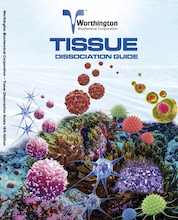For our international customers, please be advised that orders cannot be placed through our website by customers in countries with International Distributor representation.
Worthington Tissue Dissociation Guide
Methods and Materials: Equilibration with 95% O2:5% CO2
In many cell isolation procedures it is important to the survival of the tissue during dissociation that the incubation medium be both well oxygenated and buffered at physiological pH. Both requirements are satisfied when the medium is equilibrated with 95%O2:5%CO2. Several balanced salt solutions contain the pH sensitive indicator dye, phenol red. When it is red or purple in color, the medium is too alkaline. This sometimes occurs when the tissue is placed in the dissociation enzyme solution. Reequilibration with O2:CO2 is usually necessary prior to incubation.
Gas should not be bubbled directly into any solution containing protein. This can result in frothing and denaturation of the protein with loss of biological activity. Gas can be sterilized by passage through a 0.22 micron membrane filter or through a sterile fiber plug such as the cotton plug in a sterile Pasteur or volumetric pipette. While mixing the solution, pass O2:CO2 continuously through the space above the liquid until color indicates pH 7.2-7.4. The balanced salt solution is often pre-gassed but should be equilibrated with sterile O2:CO2 each time the bottle is opened.
Buffered balanced salt solutions will usually maintain constant pH regardless of the degree of oxygenation/carbonation and as a result can be easier to work with. Certain cell types may be sensitive to particular buffer salts. The reference tables can be useful in selecting an appropriate balanced salt solution, buffer, or dissociation media for a specific application.
Tissue Tables
The Worthington Tissue Tables provide references useful to researchers interested in tissue dissociation and cell harvesting procedures. The references are organized by Tissue and Species type and linked to PubMed citations. The Cell type, Enzymes, and Medium for each reference is provided.
To search by specific criteria, use the Tissue References Search Tool.
